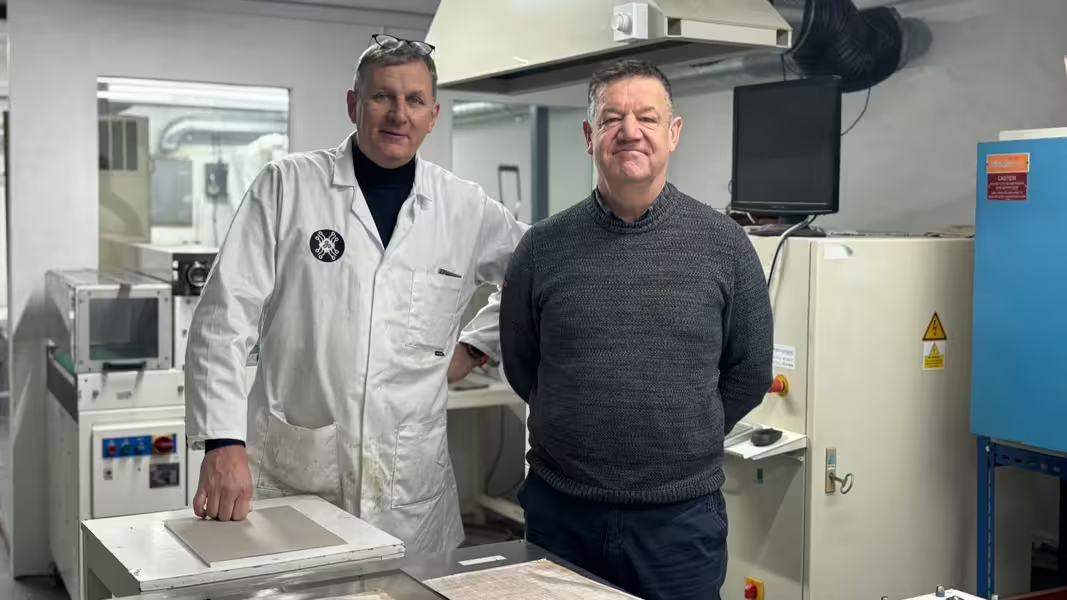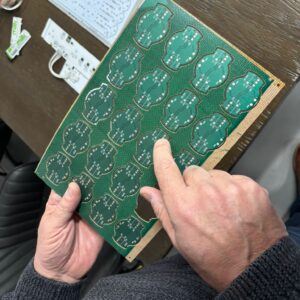The electronics industry is facing a sustainability crisis, particularly in the realm of printed circuit boards (PCBs). For decades, FR4, a fiberglass-reinforced epoxy laminate, has been the industry standard despite environmental drawbacks. Its production requires significant energy, recycling is complicated/costly and disposal methods often involve incineration or landfill, contributing to pollution.
Jiva Materials has taken the bold step to address these issues with Soluboard, a revolutionary biodegradable and recyclable PCB substrate. During a recent visit to Jiva’s facility, Sustainable Engineering’s Jon Barrett met with CEO Steve Driver to discuss the company’s achievements, innovations and future plans. What followed was a fascinating look at the progress Jiva has made and how Soluboard is redefining PCB sustainability.
Journey so far: a transformational 2024
The past year was a significant one for Jiva Materials. A major milestone was the company’s achievement of UL flammability certification, a critical step in establishing Soluboard’s viability for widespread industry use. This certification confirms the material’s safety and reinforces its potential for adoption in various sectors.
Beyond regulatory success, Jiva strengthened its market presence, collaborating with over 30 original equipment manufacturers (OEMs). These partnerships span diverse industries, from automotive and industrial electronics to consumer devices and pharmaceutical tracking solutions. Jiva’s engagement with such a broad spectrum of companies underscores the growing demand for sustainable alternatives to traditional PCBs.
Financially, the company ended 2024 on a high note. A £250,000 investment secured through a Crowdcube campaign validated investor confidence in Jiva’s technology and vision. With fresh funding in place, the company is poised to accelerate its research and development efforts while expanding its market reach.
Looking ahead: expansion and innovation in 2025
With its foundation firmly in place, Jiva Materials is gearing up for a year of expansion and refinement. One of its key objectives is team growth, with new additions including a quality manager and a marketing manager to enhance both product standards and outreach.
Jiva is also making strides on the international stage. A technical paper was recently accepted for presentation at the Apex Conference in Anaheim, California, a major event in the electronics industry. This represents a significant opportunity to introduce Soluboard to a US audience and forge connections that could propel its adoption in North America.
In parallel, Jiva is focusing on strengthening its industry credentials. The company is working towards IPC recognition and additional UL certifications, solidifying Soluboard’s standing in the market.
Perhaps most importantly, Jiva will move beyond pilot projects. Having successfully demonstrated the feasibility of its product through paid pilots with OEMs, the company is now focused on scaling production. This marks the next major step on the road to commercialization, which will gain traction in 2026.
Environmental impact
The environmental advantages of Soluboard are striking. Traditional FR4-based PCBs contribute heavily to carbon emissions and e-waste, and their recycling process often involves harsh chemicals or energy-intensive methods. Jiva, in contrast, has prioritized carbon footprint reduction. Collaborating with Portsmouth University and Glasgow University, the company conducted a life cycle analysis of Soluboard, confirming a 68 per cent reduction in carbon emissions compared to FR4-based PCBs.
This substantial improvement is achieved through Soluboard’s innovative material composition. Rather than relying on fiberglass and epoxy, Jiva has developed a PVOH-based polymer matrix reinforced with natural fibres. The result is a substrate that is fully biodegradable and far less resource-intensive to produce.
New approach to recycling and end-of-life management
Recycling PCBs has long been a complex and hazardous process. Traditional boards are difficult to break down, often requiring incineration or landfill disposal. Jiva Materials has introduced a game-changing approach to end-of-life PCB management.
Soluboard’s water-based dissolution process is central to this innovation. When exposed to hot water at approximately 90°C, the board’s polymer matrix dissolves, cleanly separating the copper and reinforcement fibres. Unlike conventional methods that rely on incineration or hazardous chemicals, this process enables easy metal recovery—allowing manufacturers to reclaim valuable materials such as copper and gold without environmental harm.
Jiva is also building a sustainable supply chain by partnering with like-minded innovators. The company is working with Ail Arion, a startup developing soluble silver ink, which could lead to fully biodegradable electronic circuits. It has also joined forces with Lilo Tree, a US startup that offers cyanide-free gold plating, providing an eco-friendlier finishing process.
Demonstrating Soluboard’s capabilities: a hands-on test
During the visit to Jiva Materials, Sustainable Engineering Magazine observed the material’s potential through a series of practical tests.
In a solubility experiment, a sample of Soluboard was immersed in hot water at 95.6°C. Over the course of 30 minutes, the polymer dissolved, leaving behind the reinforcement fibers and cleanly separated copper layers, ready for recycling. This demonstration highlighted how effectively the material breaks down without requiring harmful processing methods.
Another experiment put Soluboard’s fire resistance to the test. A sample strip was subjected to two flame exposure cycles of 10 seconds each, mimicking the UL certification process. The material successfully self-extinguished, confirming its compliance with flame-retardant safety standards.
In addition, visitors to the facility got a behind-the-scenes look at Soluboard’s manufacturing process. From the initial coating of jute fibre reinforcement with a custom PVOH-based polymer to the lamination of copper foil, every stage of production emphasized sustainability and efficiency.
Overcoming challenges and the road to widespread adoption
While Soluboard represents a major step forward in sustainable PCB technology, challenges remain. The company continues to refine the thermo-mechanical properties of the substrate to meet the demands of high-performance applications. At the same time, scalability is a key focus—ensuring that production can be ramped up to meet growing industry demand.
Perhaps the biggest challenge is market education. Many manufacturers are unfamiliar with water-soluble PCB substrates, and changing long-established industry practices takes time. Jiva’s efforts in 2025 will include extensive outreach, demonstrating not only the environmental benefits of Soluboard but also its cost-effectiveness and technical viability.
As regulatory pressures increase and electronics manufacturers look for sustainable solutions, Soluboard is positioned to lead the charge toward a greener future. With commercialisation on the horizon and growing industry recognition, Jiva’s vision of a world where PCBs are no longer an environmental liability is becoming an attainable reality.


